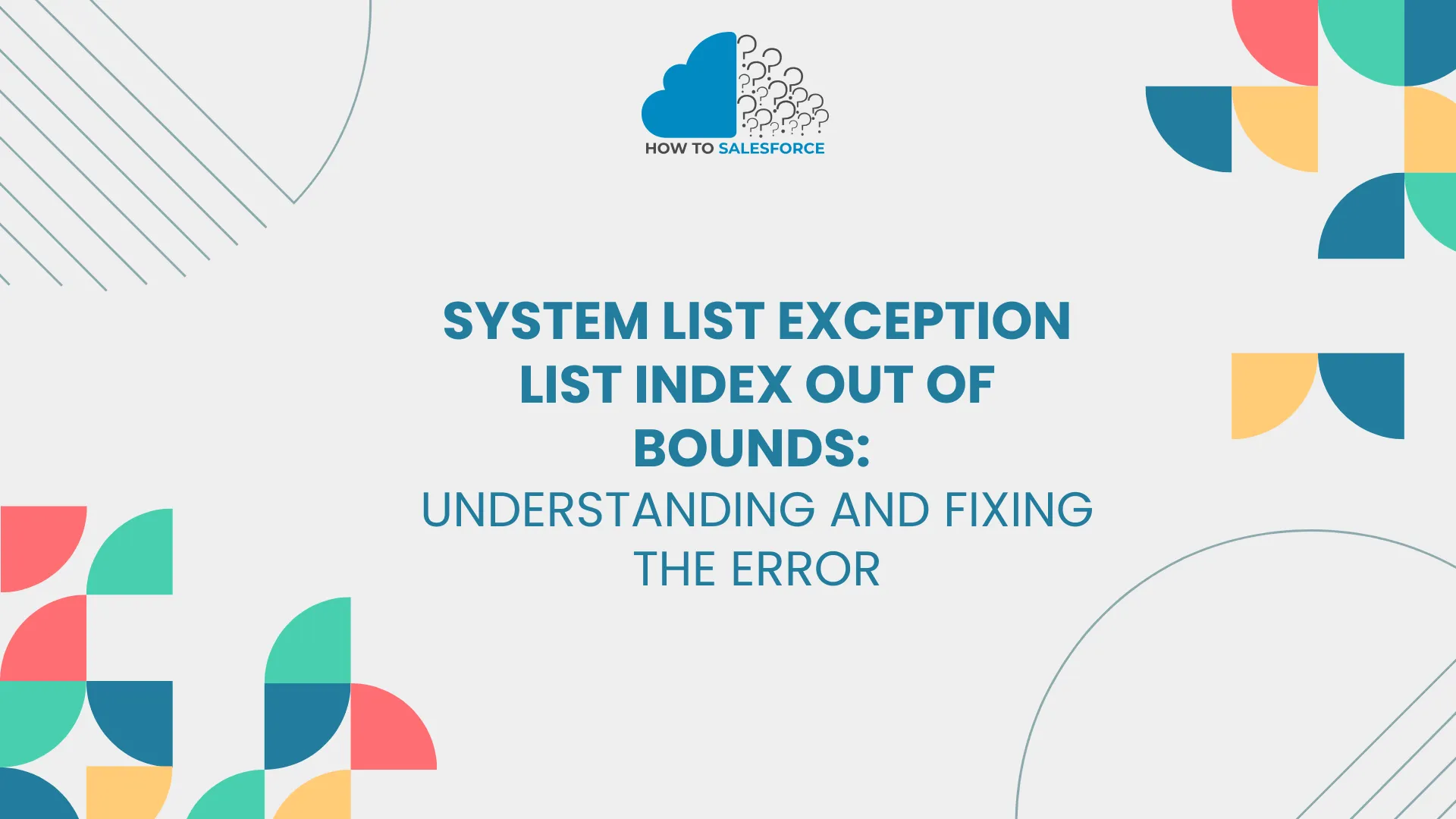The “system list exception list index out of bounds” error often appears in Salesforce development. It indicates that your code is trying to access a list element that doesn’t exist. Let’s dive deeper into understanding, identifying, and fixing this common Salesforce error to ensure smooth operation.
Read my latest blog on Salesforce Formula: Determine the Object Type of a WhatId.
What is “System List Exception List Index Out of Bounds”?
This error message generally occurs when your code attempts to access an index in a list that is out of range. Lists in Salesforce, like arrays, are zero-indexed. This means that the first element is at index 0, the second at index 1, and so forth. Thus, trying to access an index that doesn’t exist causes this error.
Examples of List Index Errors
Here are some scenarios where this error might arise:
- Trying to access the third item in a list containing only two items.
- Attempting to retrieve an element using a negative index.
- Accessing list elements in loops with incorrect conditions.
Why Does the Error Occur?
There are several reasons why this error can occur. Here’s a breakdown:
- Incorrect Index Usage: This usually happens when using a static index that exceeds the list length.
- Empty Lists: If your code doesn’t properly check whether a list is empty, accessing its elements causes errors.
- Incorrect Loop Conditions: For loops that run beyond the list’s length will cause an out-of-bounds exception.
- Dynamic List Modifications: Removing elements from a list during iteration can alter the list size and trigger this error.
Identifying the Root Cause of the Error
To resolve this issue, understanding the root cause is crucial. Here’s how you can identify it:
Step 1: Check the Error Logs
Always review your Salesforce logs for error messages. The error message will specify which line of code caused the issue. This helps narrow down your debugging.
Step 2: Inspect the List Size
Before accessing an index, check the list size using `.size()`. This ensures the index you are accessing is valid.
Step 3: Debugging with System Debug
Use `System.debug()` statements to print the list and its length at various points in your code. This helps pinpoint where your list’s size isn’t as expected.
Practical Examples of Fixing the “System List Exception List Index Out of Bounds” Error
Let’s explore some examples to better understand how to handle and prevent this error.
Example 1: Accessing an Invalid Index
```apex
List<Integer> numbers = new List<Integer>{1, 2, 3};
System.debug(numbers[5]); // This causes a "list index out of bounds" error.
```Solution
Before accessing an index, check if it’s within range:
```apex
if (numbers.size() > 5) {
System.debug(numbers[5]);
} else {
System.debug('Index out of bounds.');
}
```Example 2: Looping Beyond List Size
```apex
List<String> names = new List<String>{'John', 'Jane', 'Doe'};
for (Integer i = 0; i <= names.size(); i++) {
System.debug(names[i]); // This causes an out-of-bounds error.
}
```Solution
Adjust the loop condition:
```apex
for (Integer i = 0; i < names.size(); i++) {
System.debug(names[i]);
}
```Example 3: Handling Empty Lists
Accessing elements in an empty list can also throw this error.
```apex
List<String> fruits = new List<String>();
System.debug(fruits[0]); // Error if the list is empty.
```Solution
Always check if the list is not empty:
```apex
if (!fruits.isEmpty()) {
System.debug(fruits[0]);
} else {
System.debug('The list is empty.');
}
```Best Practices to Prevent “System List Exception List Index Out of Bounds” Errors
Prevention is better than debugging. Follow these best practices to avoid such errors in your Salesforce development:
1. Always Check List Size
Before accessing an index, confirm that it falls within the list’s bounds. Use `.size()` or `.isEmpty()` methods for validation.
2. Use Enhanced for Loops
Instead of traditional for loops, use enhanced for loops. They help prevent index-related errors.
```apex
List<String> items = new List<String>{'Item1', 'Item2'};
for (String item : items) {
System.debug(item);
}
```3. Handle Dynamic List Changes Carefully
If your code modifies a list during iteration, use caution. Instead of removing elements directly from the list, consider using a separate list to store items for deletion.
4. Validate User Inputs
If users can affect list data through inputs, validate these inputs thoroughly. This helps avoid unexpected errors during list access.
Troubleshooting Common Issues Related to List Index Errors
Even with precautions, issues might arise. Here’s how to troubleshoot effectively:
Scenario 1: Errors After Data Imports
Sometimes, after importing large datasets into Salesforce, your flows or triggers might face list index issues. In such cases:
- Validate the data before processing it.
- Ensure your code handles cases where data might be incomplete.
Scenario 2: Complex Triggers and Automation
Complex triggers accessing lists can face index issues due to data changes during record updates.
- Use `before` triggers when possible to handle data before it’s committed.
- Avoid writing overly complex triggers that alter lists in multiple places.
Scenario 3: Apex Test Classes
Sometimes, test classes can inadvertently cause index errors.
- Use realistic data in test classes.
- Always assert list sizes before accessing elements.
Advanced Tips for Managing Lists in Apex
For more experienced Salesforce developers, managing lists efficiently can improve performance and prevent errors. Here are some advanced strategies:
1. Use Sets Instead of Lists for Unique Values
Sets automatically manage duplicates, reducing the risk of index errors when handling unique values.
```apex
Set<String> emailSet = new Set<String>{'email@example.com'};
emailSet.add('email@example.com'); // No duplicate entry.
```2. Use Maps for Better Lookup Efficiency
When dealing with large datasets, consider using maps. They allow efficient lookups based on keys, which prevents errors related to list indices.
```apex
Map<String, Integer> scoreMap = new Map<String, Integer>();
scoreMap.put('John', 95);
System.debug(scoreMap.get('John'));
```3. Leverage Collection Methods
Salesforce offers various collection methods that simplify list handling:
- `.contains()` to check for specific elements.
- `.clear()` to empty the list safely.
- `.remove()` to delete specific elements by value.
Conclusion
Understanding how to handle the “system list exception list index out of bounds” error is crucial for Salesforce developers. This error can disrupt processes, causing issues with automation and data handling. By following best practices and implementing safeguards, you can prevent this error from occurring.
Ensure you always validate list sizes, handle user inputs carefully, and optimize your code. Doing so improves performance, reduces errors, and enhances the reliability of your Salesforce environment.
In summary, mastering where to find and fix list index issues is essential. Properly managing lists in Apex ensures that your Salesforce applications run smoothly, without unexpected interruptions.


